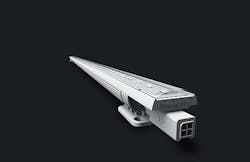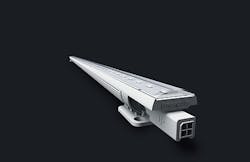Lumenpulse has announced the Lumencove Nano LED luminaire that targets linear cove lighting applications with a scalable 1-ft or 4-ft design that can be cascaded into longer runs. The fixture also integrates AC-LED driver technology -- a technology the company calls Lumendrive -- directly onto the printed circuit board (PCB) that hosts the LEDs so that the fixture can be connected directly to the AC line.
The company is touting the Lumendrive technology as eliminating the power supply or driver that's commonly used with LED lighting, and therefore boosting the fixture reliability. But as we've discussed before, AC-driver technology is really just another driver topology that comes with advantages and disadvantages relative to the more common AC-DC driver used in solid-state lighting (SSL).
"By removing the power supply, we reduced the size of the product and improved performance -- without sacrificing sustainability or reliability," said Greg Campbell, senior vice president and CTO at Lumenpulse. "Lumendrive lets us avoid the typical efficiency losses that occur in the AC-to-DC power conversion with embedded power supplies, allowing us to provide best-in-class efficiency."
The fixture delivers 100 lm/W in efficacy and 559 lm/ft. Those specifications are not industry tops but are certainly competitive. In the past, AC-LED-based products have trailed more traditional DC-driven designs in efficacy and lumen output but the gap has closed considerably.
AC vs. DC
Still, the comparison of the Lumenpulse design with other products must go deeper. The company is using a custom IC to implement the Lumendrive AC-drive technology. Campbell would not name the IC supplier but said that Lumenpulse had found a partner that was using technology similar to a typical AC-LED step-drive topology in a completely different application and was able to have that unnamed company customize the Lumendrive implementation without facing the huge nonrecurring engineering costs associated with a full-custom IC.
The step-drive approach, used by a number of companies including Seoul Semiconductor, groups LEDs into segments with the segments forming a series string. As the AC voltage level rises, first one and then the subsequent segments sequentially light up. The downside to such a topology is that all of the LEDs are not switched on for the same amount of time. The different duty cycles can result in uneven light levels from segment to segment, and lower overall efficacy.
The step-drive technique essentially reduces the utilization level of the LEDs in a system, and that would effectively add cost because more LEDs would be required to reach the same light levels of a DC-driven alternative. Campbell points out, however, that the simpler driver more than makes up for the LED cost differential.
At the system level, however, the product designers also had to compensate for the different light levels associated with LEDs in different segments. AC-LED technology has been used in applications such as downlights where the LEDs are grouped closely together and the differences in light levels between individual components are not as important as the total lumen output in the beam. In the linear applications, with individual LEDs spaced apart along the length, inconsistencies could be noticeable.
Color and lumen consistency
Campbell said the company employed two techniques to deliver consistency along the length of the Lumencove fixture. The company used binned LEDs and placed the brighter LEDs in segments that have lower duty cycles -- the LEDs at the top end of the series string relative to the rising AC line voltage. Moreover, the design intersperses LEDs from different segments along the length of the fixtures as opposed to just connecting each segment sequentially along the fixture. Specifiers will have to peruse the photometric tests, available to potential customers from Lumenpulse, and their own evaluations to determine if the consistency matches specific application requirements.
Back to the product, Lumencove Nano is easily scaled for runs as long as 300 ft. Indeed, the sections include electrical connectors that can pass through the AC power from segment to segment. Each segment includes its own AC-driver implementation.
The design is dimmable using 0-10V controls. Indeed, Campbell said dimming performance was one of the primary motivations that drove the company to develop the Lumendrive IC. He said that most other AC-drive implementations lack uniform dimming capability at the low end of the dimming range. Campbell would not reveal details of how the company implemented the dimming capability beyond saying that the design modulates the current to each segment.
The Lumencove Nano can also take dimming controls over the company's Lumentalk power-line network scheme. And the company can bridge phase-controlled dimmers to Lumentalk.
Lumenpulse will warranty the new product for ten years and is projecting 100,000 hours of life. Presumably, the AC-driver technology is behind such longevity, although there have been DC-driven SSL products on the market with such warranties for going on two years. Clearly, you can realize reliable products using a number of driver topologies, but lighting designers and specifiers will choose products taking into account many factors including color and lumen consistency, and efficacy -- as well as lifetime.






